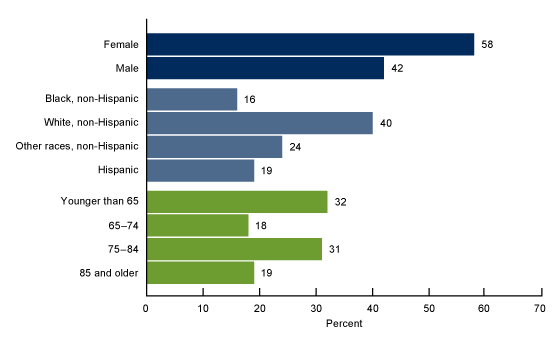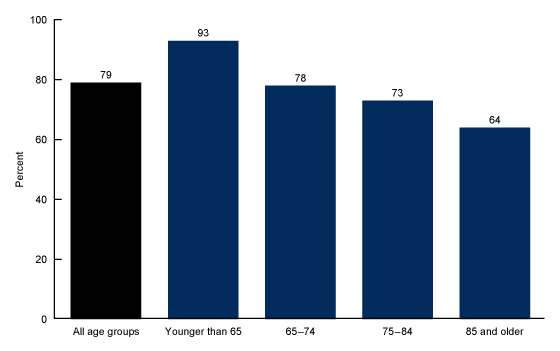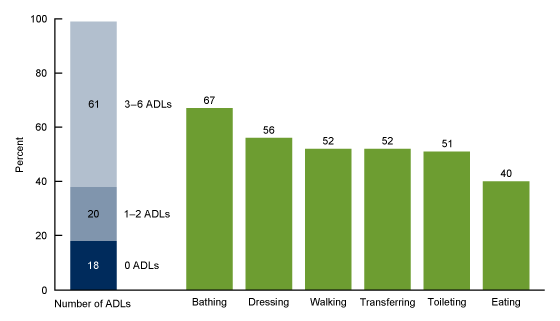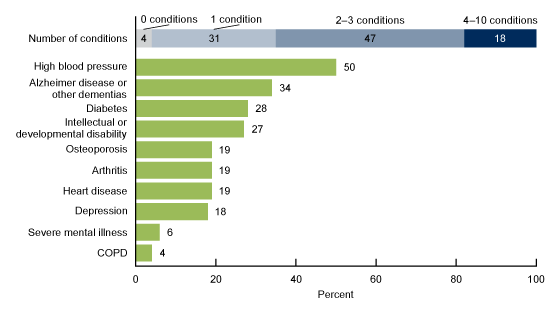Adult Day Services Center Participant Characteristics: United States, 2022
- Key findings
- Most ADSC participants were female, of another race and Hispanic origin than White non-Hispanic, and age 65 and older.
- Most ADSC participants were Medicaid users, and Medicaid usage varied by age group.
- Most ADSC participants needed assistance with ADLs.
- Most ADSC participants were diagnosed with two or more of the most common chronic conditions.
- Summary
Data from the National Post-acute and Long-term Care Study
- In 2022, 58% of adult day services center participants were female, 40% were White non-Hispanic, and 32% were younger than age 65.
- Most adult day services center participants were Medicaid users.
- About 61% of adult day services center participants needed assistance with three to six activities of daily living.
- Most adult day services participants had two or more chronic conditions, and one-half of participants were diagnosed with high blood pressure.
In 2022, an estimated 3,100 adult day services centers (ADSC) served about 182,000 participants in the United States (1). ADSCs provide long-term and post-acute care services, both medical and social, to adults with disabilities. ADSC participants tend to be younger and more racially and ethnically diverse than users of other long-term care services (2,3). Many participants need assistance with activities of daily living (ADL) and have chronic health conditions (3,4). This report contains the most recent national estimates of selected characteristics of ADSC participants from the 2022 National Post-acute and Long-term Care Study (5).
Keywords: Medicaid, activities of daily living (ADL), home and community-based services, chronic conditions, National Post-acute and Long-term Care Study (NPALS)
Most ADSC participants were female, of another race and Hispanic origin than White non-Hispanic, and age 65 and older.
- About 6 out of 10 ADSC participants were female (58%) (Figure 1, Table 1).
- Among participants, 40% were White non-Hispanic (subsequently, White). About 19% were Hispanic, 16% were Black non-Hispanic, and 24% were other race non-Hispanic.
- About 68% of participants were age 65 and older, 32% were younger than age 65, 31% were ages 75–84, 19% were age 85 and older, and 18% were ages 65–74.
Figure 1. Sex, race and Hispanic origin, and age group of adult day services center participants: United States, 2022

NOTES: Other race non-Hispanic includes American Indian and Alaska Native, Asian, Native Hawaiian and Other Pacific Islander, and more than one race, all non-Hispanic. See “Data source and methods” in this report for details on the study and methodology. Figure excludes cases with missing data. Percentages are based on unrounded numbers; estimates may not sum to totals because of rounding.
SOURCE: National Center for Health Statistics, 2022 National Post-acute and Long-term Care Study.
Most ADSC participants were Medicaid users, and Medicaid usage varied by age group.
- About 79% of all ADSC participants had some or all of their services paid by Medicaid (Figure 2, Table 2).
- Nearly all of participants younger than age 65 were Medicaid users (93%). About 78% of participants ages 65–74, 73% of participants ages 75–84, and 64% of participants age 85 and older used Medicaid.
Figure 2. Medicaid use of adult day services center participants, overall and by age group: United States, 2022

NOTES: Medicaid use includes participants who had some or all of their adult day services paid by Medicaid during the 30 days prior to the survey. Figure excludes cases with missing data. See “Data source and methods” in this report for details on the study and methodology.
SOURCE: National Center for Health Statistics, 2022 National Post-acute and Long-term Care Study.
Most ADSC participants needed assistance with ADLs.
- Among ADSC participants, 18% did not need assistance with ADLs, 20% needed assistance with one to two ADLs, and 61% needed assistance with three to six ADLs (Figure 3, Table 3).
- Assistance need varied by activity, ranging from 67% of participants needing help with bathing to 40% needing help with eating.
Figure 3. Adult day services center participants needing assistance with activities of daily living: United States, 2022

NOTES: Needing assistance with activities of daily living (ADL) refers to participants needing any help or supervision from another person, use of assistive devices, or both. Walking includes using a cane, walker, or wheelchair, or help from another person. Transferring includes needing assistance getting in and out of a bed or chair. Individual ADLs are not mutually exclusive; a participant can need assistance with more than one ADL. Percentages for number of ADLs are based on unrounded numbers; estimates may not add to 100 due to rounding. Figure excludes cases with missing data. See “Data source and methods” in this report for details on the study and methodology.
SOURCE: National Center for Health Statistics, 2022 National Post-acute and Long-term Care Study.
Most ADSC participants were diagnosed with two or more of the most common chronic conditions.
- Among ADSC participants, 4% did not have any of the 10 most common chronic conditions, 31% had 1 condition, 47% had 2 or 3 conditions, and 18% had 4 to 10 of the most common chronic conditions (Figure 4, Table 4).
- The 10 most common chronic conditions were high blood pressure (50%), Alzheimer disease or other dementias (34%), diabetes (28%), intellectual and developmental disabilities (27%), osteoporosis (19%), arthritis (19%), heart disease (19%), depression (18%), severe mental illness (6%), and chronic obstructive pulmonary disease (4%).
Figure 4. Most common chronic conditions of adult day services center participants: United States, 20222

NOTES: High blood pressure includes hypertension. Arthritis includes rheumatoid arthritis. Heart disease includes conditions such as congestive heart failure, coronary or ischemic heart disease, and heart attack. Severe mental illness includes schizophrenia or psychosis or bipolar disorder (excludes depression or anxiety disorder). COPD is chronic obstructive pulmonary disease and includes chronic bronchitis and emphysema. Individual conditions are not mutually exclusive; a participant can be counted in more than one condition. Number of conditions includes only the 10 conditions in this figure, and participants may have other conditions not presented here. Figure excludes cases with missing data. See “Data source and methods” in this report for details on the study and methodology.
SOURCE: National Center for Health Statistics, 2022 National Post-acute and Long-term Care Study.
Summary
In 2022, most ADSC participants in the United States were female (58%), of another race and Hispanic origin than White (60%), and were age 65 and older (68%). Nearly all participants younger than age 65 used Medicaid to pay for some or all ADSC services. About 80% of ADSC participants needed assistance with at least one of the six ADLs. Bathing was the most common ADL that required assistance. Almost two-thirds of participants were diagnosed with at least two chronic conditions. The most common chronic condition among participants was high blood pressure.
This report provides the most current national estimates of selected characteristics of ADSC participants in the United States. These data provide information to researchers, policy makers, and others to address the needs of adults within home- and community-based care settings.
Definitions
Adult day services centers (ADSC): A community-based center, generally open on weekdays, that provides long-term and post-acute care services, including structured activities, health monitoring, socialization, and assistance with ADLs to adults with disabilities.
Arthritis: Includes rheumatoid arthritis.
Assistance with selected activities of daily living (ADL): Refers to participants needing any help or supervision from another person or use of assistive devices, at their usual residence or at the ADSC, due to limitations in bathing, walking or locomotion, dressing, transferring in and out of a chair, toileting, or eating.
Chronic obstructive pulmonary disease: Includes chronic bronchitis and emphysema.
Heart disease: Includes congestive heart failure, coronary or ischemic heart disease, and heart attack.
High blood pressure: Includes hypertension.
Medicaid user: Refers to participants who had some or all of their long-term care services paid by Medicaid during the 30 days before the survey, including funding from a Medicaid state plan, Medicaid waiver, Medicaid managed care, or from a California regional center.
Other race and Hispanic origin: Includes participants of the following racial and ethnic backgrounds: American Indian and Alaska Native non-Hispanic, Asian non-Hispanic, Native Hawaiian or Other Pacific Islander non-Hispanic, and two or more races non-Hispanic.
Severe mental illness: Includes schizophrenia or psychosis or bipolar disorder. Excludes depression or anxiety disorder.
Data source and methods
Data are from the ADSC component of the 2022 wave of the biennial National Post-acute and Long-term Care Study, conducted by the National Center for Health Statistics. The survey used a random sample of participants, obtained from a stratified sample of ADSCs that were operating in the United States in 2022 and that met the study eligibility criteria. More details about the study, including eligibility criteria, design, and measures, are available from https://www.cdc.gov/nchs/npals/questionnaires/#cdc_listing_res3-2022 and in the survey methodology document (1).
The percentage of cases with missing data for variables in this report ranged from 0.2% for all chronic conditions to 11.9% for bathing. Of the missing data for bathing, 10.3% of cases responded “don’t know”, and these were coded as missing. Missing cases were excluded from the analyses on a variable-by-variable basis. Data analyses were performed using Stata/SE version 17.0 (6). Analyses incorporated complex survey weights and followed National Center for Health Statistics presentation standards for proportions (7).
About the authors
Jessica P. Lendon, Priyanka Singh, and Zhaohui Lu are with the National Center for Health Statistics, Division of Health Care Statistics.
References
- National Center for Health Statistics. 2022 National Post-acute and Long-term Care Study: Survey methodology for the adult day services center and residential care community components.
- Lendon JP, Rome V, Sengupta M. Variations between adult day services centers in the United States by the racial and ethnic case-mix of center participants. J Appl Gerontol 40(9):1029–38. 2021. DOI: https://dx.doi.org/10.1177/0733464820934996
- National Center for Health Statistics. Biennial overview of post-acute and long-term care in the United States: Data from the 2020 National Post-acute and Long-term Care Study. 2023.
- Singh P, Lu Z, Sengupta M. Variation in adult day services center participant characteristics by center ownership: United States, 2020. NCHS Data Brief, no 453. Hyattsville, MD: National Center for Health Statistics. 2022. DOI: https://dx.doi.org/10.15620/cdc:122046.
- Lendon JP, Singh P. Adult day services center participant characteristics: United States, 2018. NCHS Data Brief, no 411. Hyattsville, MD: National Center for Health Statistics. 2021.
- StataCorp. Stata Statistical Software (Release 17) [computer software]. 2021.
- Parker JD, Talih M, Malec DJ, Beresovsky V, Carroll M, Gonzalez JF Jr., et al. National Center for Health Statistics data presentation standards for proportions. National Center for Health Statistics. Vital Health Stat 2(175). 2017.
Suggested citation
Lendon JP, Singh P, Lu Z. Adult day services center participant characteristics: United States, 2022. NCHS Data Brief, no 502. Hyattsville, MD: National Center for Health Statistics. 2024. DOI: https://dx.doi.org/10.15620/cdc/157498.
Copyright information
All material appearing in this report is in the public domain and may be reproduced or copied without permission; citation as to source, however, is appreciated.
National Center for Health Statistics
Brian C. Moyer, Ph.D., Director
Amy M. Branum, Ph.D., Associate Director for Science
Division of Health Care Statistics
Carol J. DeFrances, Ph.D., Director
Alexander Strashny, Ph.D., Associate Director for Science